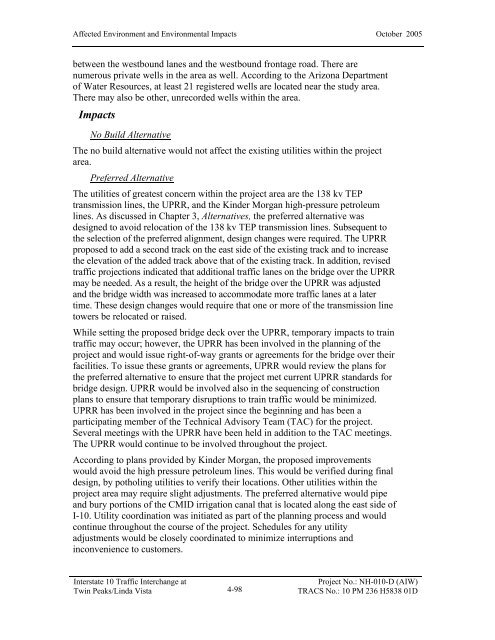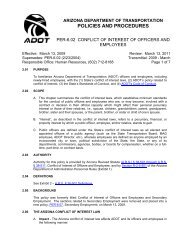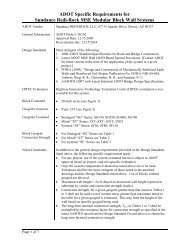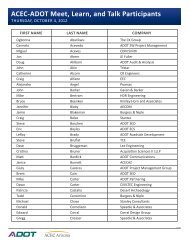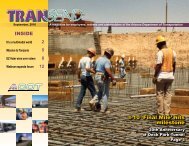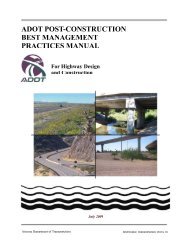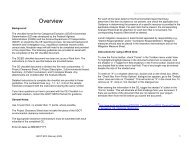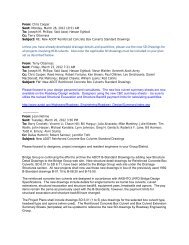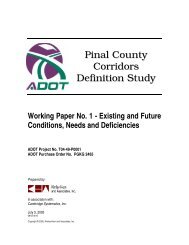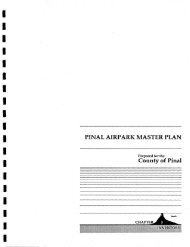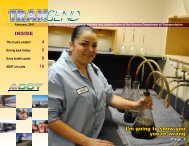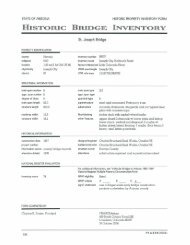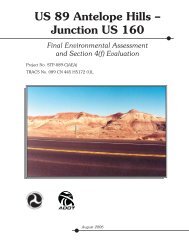I-10 Twin Peaks Traffic Interchange, Environmental Assessment
I-10 Twin Peaks Traffic Interchange, Environmental Assessment
I-10 Twin Peaks Traffic Interchange, Environmental Assessment
You also want an ePaper? Increase the reach of your titles
YUMPU automatically turns print PDFs into web optimized ePapers that Google loves.
Affected Environment and <strong>Environmental</strong> Impacts October 2005<br />
between the westbound lanes and the westbound frontage road. There are<br />
numerous private wells in the area as well. According to the Arizona Department<br />
of Water Resources, at least 21 registered wells are located near the study area.<br />
There may also be other, unrecorded wells within the area.<br />
Impacts<br />
No Build Alternative<br />
The no build alternative would not affect the existing utilities within the project<br />
area.<br />
Preferred Alternative<br />
The utilities of greatest concern within the project area are the 138 kv TEP<br />
transmission lines, the UPRR, and the Kinder Morgan high-pressure petroleum<br />
lines. As discussed in Chapter 3, Alternatives, the preferred alternative was<br />
designed to avoid relocation of the 138 kv TEP transmission lines. Subsequent to<br />
the selection of the preferred alignment, design changes were required. The UPRR<br />
proposed to add a second track on the east side of the existing track and to increase<br />
the elevation of the added track above that of the existing track. In addition, revised<br />
traffic projections indicated that additional traffic lanes on the bridge over the UPRR<br />
may be needed. As a result, the height of the bridge over the UPRR was adjusted<br />
and the bridge width was increased to accommodate more traffic lanes at a later<br />
time. These design changes would require that one or more of the transmission line<br />
towers be relocated or raised.<br />
While setting the proposed bridge deck over the UPRR, temporary impacts to train<br />
traffic may occur; however, the UPRR has been involved in the planning of the<br />
project and would issue right-of-way grants or agreements for the bridge over their<br />
facilities. To issue these grants or agreements, UPRR would review the plans for<br />
the preferred alternative to ensure that the project met current UPRR standards for<br />
bridge design. UPRR would be involved also in the sequencing of construction<br />
plans to ensure that temporary disruptions to train traffic would be minimized.<br />
UPRR has been involved in the project since the beginning and has been a<br />
participating member of the Technical Advisory Team (TAC) for the project.<br />
Several meetings with the UPRR have been held in addition to the TAC meetings.<br />
The UPRR would continue to be involved throughout the project.<br />
According to plans provided by Kinder Morgan, the proposed improvements<br />
would avoid the high pressure petroleum lines. This would be verified during final<br />
design, by potholing utilities to verify their locations. Other utilities within the<br />
project area may require slight adjustments. The preferred alternative would pipe<br />
and bury portions of the CMID irrigation canal that is located along the east side of<br />
I-<strong>10</strong>. Utility coordination was initiated as part of the planning process and would<br />
continue throughout the course of the project. Schedules for any utility<br />
adjustments would be closely coordinated to minimize interruptions and<br />
inconvenience to customers.<br />
Interstate <strong>10</strong> <strong>Traffic</strong> <strong>Interchange</strong> at<br />
<strong>Twin</strong> <strong>Peaks</strong>/Linda Vista<br />
4-98<br />
Project No.: NH-0<strong>10</strong>-D (AIW)<br />
TRACS No.: <strong>10</strong> PM 236 H5838 01D


